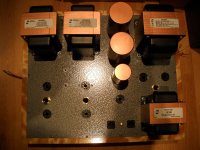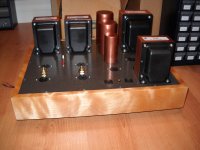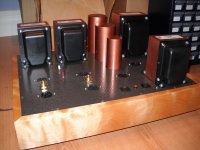Thanks also for bringing up the welding practice. I don't know if Hammond process this way (I don't think so as I did not noticed them) but it's a good point you brought up there.
I doubt that hammond weld the lamination stack, it is more common with rugged industrial and automotive devices alternators, welding transformers and chokes being the main users of this technique I have also seen a few electric motors with welded stacks.
As for thinners entering the lamination stack, even if they did the insulation between the laminations is a specially formed oxide layer which is unaffected by heat and solvents.
As basic I thought this thread would be, I'm happy from all your input as it is very informative on the different techniques you are proposing and on the expertise you have gained over the years. It'll certainly help other people in the future also.
Hammond (the rep) confirmed that he have spoke to engineers and confirmed that it was ok to sand down to bare metal without problem. He will ask if the stacks are welded and come back to me early this week. I told him that I would take care of fixing the lamination finish but I asked so they send me a new 193M choke since the baked varnish peels of too easy. After all they are under warranty and he mentionned that I need to be satisfied with the product I purchased. Good thing to know from hammond.
If Hammond weld the stacks, would it be visible? Generally, is it visible from the lamination side or from the surface side?
Hammond (the rep) confirmed that he have spoke to engineers and confirmed that it was ok to sand down to bare metal without problem. He will ask if the stacks are welded and come back to me early this week. I told him that I would take care of fixing the lamination finish but I asked so they send me a new 193M choke since the baked varnish peels of too easy. After all they are under warranty and he mentionned that I need to be satisfied with the product I purchased. Good thing to know from hammond.
If Hammond weld the stacks, would it be visible? Generally, is it visible from the lamination side or from the surface side?
After you have spent some time with the lacquer thinner try using Acetone, same amount in a metal tray. Use double vinyl or other protective film gloves to avoid poisoning your self. This will melt the polyester resin that is likely the varnish used. Just wipe the core edges with a wet strength paper towel now and again until you get it as smooth as you want. Once the resin has reset, lightly sand the paper residue off and paint.
I am a transformer engineer and this is what we do in our plant to refinish or dismantle the transformer core. I would remove the endbells and bolts. keeping the isolation washers where they are on the bolts. Don't loose those, ever!!!!! Then perhaps rebolt the core with some appropriate size just to keep the pieces of I lam from dropping out.
Bud
Thanks for being precise on the whole cleaning process. Can't I use the original bolts and washers while I'm doing the job???
If Hammond weld the stacks, would it be visible? Generally, is it visible from the lamination side or from the surface side?
Yes it would, The welding is to hold the lamination stack together and prevent vibration Hammond appears to use bolted stacks. The welding is always on the outside of the stack with a clearly visible bead.
Thanks to all who posted. I decided to go the shortest way and sand down the plate edges since Hammond confirmed it was ok to proceed that way. It went very well, the varnish (or whatever it is dipped in) came off easy. I made sure to remove dust with lacquer thinner afterwards. Take a look at the pictures, I added copper finish paint.
BTW, I noticed also, that Hammond transformers are assembled very quickly. One of my OPT has phenolic washer and the other one had plastic sleeves. The PT had two crushed plastic sleeves. That lets me perplex about their Quality department.
What's the use of plastic sleeve? Is it only there to center the bolt and isolate it from short circuit? Considering I have phenolic flat washer on one OPT, I estimate there are risk (electrical) if the bolt touches the lamitions?
I will contact Hammond on that situation.
Now it's time to solder up the components and think wisely how to best route the point-to-point wiring.
Thanks!
Happy New Year!
BTW, I noticed also, that Hammond transformers are assembled very quickly. One of my OPT has phenolic washer and the other one had plastic sleeves. The PT had two crushed plastic sleeves. That lets me perplex about their Quality department.
What's the use of plastic sleeve? Is it only there to center the bolt and isolate it from short circuit? Considering I have phenolic flat washer on one OPT, I estimate there are risk (electrical) if the bolt touches the lamitions?
I will contact Hammond on that situation.
Now it's time to solder up the components and think wisely how to best route the point-to-point wiring.
Thanks!
Happy New Year!
Attachments
- Status
- Not open for further replies.


